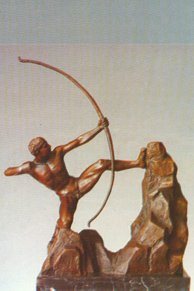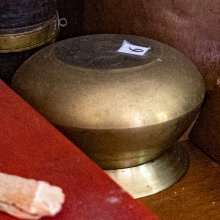Kunta, Kumta, Kuṇṭā, Kuntā, Kūṇṭā: 24 definitions
Introduction:
Kunta means something in Buddhism, Pali, Hinduism, Sanskrit, Jainism, Prakrit, the history of ancient India, Tamil. If you want to know the exact meaning, history, etymology or English translation of this term then check out the descriptions on this page. Add your comment or reference to a book if you want to contribute to this summary article.
Images (photo gallery)
(+4 more images available)
In Hinduism
Shilpashastra (iconography)
Source: Red Zambala: Hindu Icons and Symbols | Inner Circle IVThe spear (kunta) of Murugand represents the focussed mind directed at the goal to be obtained or the enemy to be slain in the form of self-referent desire (kāma), anger (krodha), delusion (moha), arrogance or feeling of superiority (mada), niggardliness (lobha), and malicious envy (mātsarya).
Source: Red Zambala: Hindu Icons and Symbols | IntroductionKunta (Spear) - One-pointedness of concentration applied during meditation aimed at the goal of perfection. Focussed attention at eliminating the inner demons of delusion, anger, greed etc.

Shilpashastra (शिल्पशास्त्र, śilpaśāstra) represents the ancient Indian science (shastra) of creative arts (shilpa) such as sculpture, iconography and painting. Closely related to Vastushastra (architecture), they often share the same literature.
Dhanurveda (science of warfare)
Source: Wisdom Library: DhanurvedaKunta (कुन्त) refers to a weapon (“spear”). It is a Sanskrit word defined in the Dhanurveda-saṃhitā, which contains a list of no less than 117 weapons. The Dhanurveda-saṃhitā is said to have been composed by the sage Vasiṣṭha, who in turn transmitted it trough a tradition of sages, which can eventually be traced to Śiva and Brahmā.

Dhanurveda (धनुर्वेद) refers to the “knowledge of warfare” and, as an upaveda, is associated with the Ṛgveda. It contains instructions on warfare, archery and ancient Indian martial arts, dating back to the 2nd-3rd millennium BCE.
Natyashastra (theatrics and dramaturgy)
Source: Wisdom Library: Nāṭya-śāstraKunta (कुन्त) refers to the “javelin”, a weapon which should measure should measure ten tālas (unit of measurement), according to Nāṭyaśāstra chapter 23. In dramatic plays, weapons such as bhiṇḍi should be made by experts using proper measurements and given to persons engaged in a fight, angry conflict or siege. It forms a component of āhāryābhinaya (extraneous representation).

Natyashastra (नाट्यशास्त्र, nāṭyaśāstra) refers to both the ancient Indian tradition (shastra) of performing arts, (natya—theatrics, drama, dance, music), as well as the name of a Sanskrit work dealing with these subjects. It also teaches the rules for composing Dramatic plays (nataka), construction and performance of Theater, and Poetic works (kavya).
Purana and Itihasa (epic history)
Source: archive.org: Shiva Purana - English TranslationKunta (कुन्त) refers to “javelins”, according to the Śivapurāṇa 2.4.7 (“Commencement of the War”).—Accordingly, as Brahmā narrated to Nārada: “[...] The backs of some were torn with javelins (kunta) and goads. Several heads chopped off by double-edged swords fell on the ground. Hundreds of headless, limbless trunks were seen dancing and bouncing with arrows sticking to their hands. Blood flowed like streams in hundreds of places. Hundreds of ghosts and goblins flocked there. [...]”.

The Purana (पुराण, purāṇas) refers to Sanskrit literature preserving ancient India’s vast cultural history, including historical legends, religious ceremonies, various arts and sciences. The eighteen mahapuranas total over 400,000 shlokas (metrical couplets) and date to at least several centuries BCE.
In Buddhism
Theravada (major branch of Buddhism)
Source: Pali Kanon: Pali Proper NamesA throne (for an image) which was originally in the Pacina vihara of the Theravadins, and was later set up beside the Bodhi tree of the Abhayagiri vihara by Silakala (Cv.xli.31).
Theravāda is a major branch of Buddhism having the the Pali canon (tipitaka) as their canonical literature, which includes the vinaya-pitaka (monastic rules), the sutta-pitaka (Buddhist sermons) and the abhidhamma-pitaka (philosophy and psychology).
Tibetan Buddhism (Vajrayana or tantric Buddhism)
Source: academia.edu: The Structure and Meanings of the Heruka MaṇḍalaKunta (कुन्त) refers to a type of lance and represents one of the items held in the right hand of Heruka: one of the main deities of the Herukamaṇḍala described in the 10th century Ḍākārṇava chapter 15. Heruka is positioned in the Lotus (padma) at the center; He is the origin of all heroes; He has 17 faces (with three eyes on each) and 76 arms [holding, for example, kunta]; He is half black and half green in color; He is dancing on a flaming sun placed on Bhairava and Kālarātrī.

Tibetan Buddhism includes schools such as Nyingma, Kadampa, Kagyu and Gelug. Their primary canon of literature is divided in two broad categories: The Kangyur, which consists of Buddha’s words, and the Tengyur, which includes commentaries from various sources. Esotericism and tantra techniques (vajrayāna) are collected indepently.
In Jainism
General definition (in Jainism)
Source: archive.org: Een Kritische Studie Van Svayambhūdeva’s PaümacariuKunta (कुन्त) participated in the war between Rāma and Rāvaṇa, on the side of the latter, as mentioned in Svayambhūdeva’s Paumacariu (Padmacarita, Paumacariya or Rāmāyaṇapurāṇa) chapter 57ff. Svayambhū or Svayambhūdeva (8th or 9th century) was a Jain householder who probably lived in Karnataka. His work recounts the popular Rāma story as known from the older work Rāmāyaṇa (written by Vālmīki). Various chapters [mentioning Kunta] are dedicated to the humongous battle whose armies (known as akṣauhiṇīs) consisted of millions of soldiers, horses and elephants, etc.

Jainism is an Indian religion of Dharma whose doctrine revolves around harmlessness (ahimsa) towards every living being. The two major branches (Digambara and Svetambara) of Jainism stimulate self-control (or, shramana, ‘self-reliance’) and spiritual development through a path of peace for the soul to progess to the ultimate goal.
India history and geography
Source: Cologne Digital Sanskrit Dictionaries: Indian Epigraphical GlossaryKunta.—(Chamba), name of a tax. Note: kunta is defined in the “Indian epigraphical glossary” as it can be found on ancient inscriptions commonly written in Sanskrit, Prakrit or Dravidian languages.
--- OR ---
Kuṇṭa.—(EI 21), a land measure; cf. guṇṭha. Note: kuṇṭa is defined in the “Indian epigraphical glossary” as it can be found on ancient inscriptions commonly written in Sanskrit, Prakrit or Dravidian languages.

The history of India traces the identification of countries, villages, towns and other regions of India, as well as mythology, zoology, royal dynasties, rulers, tribes, local festivities and traditions and regional languages. Ancient India enjoyed religious freedom and encourages the path of Dharma, a concept common to Buddhism, Hinduism, and Jainism.
Languages of India and abroad
Pali-English dictionary
Source: BuddhaSasana: Concise Pali-English Dictionarykunta : (m.) 1. sceptre lance; 2. a kind of bird.
Source: Sutta: The Pali Text Society's Pali-English DictionaryKunta, (cp. Sk. kunta lance?) a kind of bird, otherwise called adāsa J. IV, 466. (Page 221)

Pali is the language of the Tipiṭaka, which is the sacred canon of Theravāda Buddhism and contains much of the Buddha’s speech. Closeley related to Sanskrit, both languages are used interchangeably between religions.
Sanskrit dictionary
Source: DDSA: The practical Sanskrit-English dictionaryKunta (कुन्त).—
1) A lance, a barbed dart, spear; कुन्ताः प्रविशन्ति (kuntāḥ praviśanti) K. P.2. (i. e. kuntadhāriṇaḥ puruṣāḥ); विरहिनिकृन्तनकुन्तमुखाकृ- तिकेतकिदन्तुरिताशे (virahinikṛntanakuntamukhākṛ- tiketakidanturitāśe) Gītagovinda 1. Mahābhārata (Bombay) 6.96.57.
2) A small animal, an insect.
3) A kind of grain.
4) Passion.
Derivable forms: kuntaḥ (कुन्तः).
Source: Cologne Digital Sanskrit Dictionaries: Edgerton Buddhist Hybrid Sanskrit DictionaryKunta (कुन्त).—(1) m. (Sanskrit Lex.; see kunta-pipīlikā), a small insect (ant ?): Mahāvyutpatti 4851 °taḥ = Tibetan srin bu phre-ḥu, small insect; followed by 4852 pipīlikā; (2) nt., tax, tri- bute: Mahāvyutpatti 7301 °tam = Tibetan dpya.
Source: Cologne Digital Sanskrit Dictionaries: Shabda-Sagara Sanskrit-English DictionaryKunta (कुन्त).—mf. (-ntaḥ-ntī) 1. A bearded dart, a lance. m.
(-ntaḥ) 1. A species of grain, (Coix barbata, Rox.) 2. A small animal, an insect. 3. Passionateness. f. (-ntiḥ or -ntī) 1. A wife af Pandu, and mother of the three elder Pandava princes, by as many gods. 2. The gum olibanum tree, (Boswelia thurifera.) 3. Beellium, a fragrant resin. 4. The wife of a Brahman. E. ku bad, and anta end, destroying ill, enemies, &c. or ka the head, and unda to give pain, ta substituted for da fem. affix in or ṅīṣ.
Source: Cologne Digital Sanskrit Dictionaries: Benfey Sanskrit-English DictionaryKunta (कुन्त).—m. A lance, [Rāmāyaṇa] 3, 28, 24.
Source: Cologne Digital Sanskrit Dictionaries: Cappeller Sanskrit-English DictionaryKunta (कुन्त).—[masculine] spear, lance.
Source: Cologne Digital Sanskrit Dictionaries: Monier-Williams Sanskrit-English Dictionary1) Kunta (कुन्त):—m. a spear, lance (cf. [Latin] contus; [Greek] κοντός), [Rāmāyaṇa] etc.
2) a small animal, insect, [cf. Lexicographers, esp. such as amarasiṃha, halāyudha, hemacandra, etc.]
3) a species of grain (Coix barbata), [cf. Lexicographers, esp. such as amarasiṃha, halāyudha, hemacandra, etc.]
4) passion, [cf. Lexicographers, esp. such as amarasiṃha, halāyudha, hemacandra, etc.]
5) the god of love, [Demetrius Galanos’s Lexiko: sanskritikes, anglikes, hellenikes]
Source: Cologne Digital Sanskrit Dictionaries: Yates Sanskrit-English DictionaryKunta (कुन्त):—[(ntaḥ-ntā)] 1. m. f. A bearded lance. m. Species of grain; an insect. f. Wife of Pāndu; bdellium.
Source: DDSA: Paia-sadda-mahannavo; a comprehensive Prakrit Hindi dictionary (S)Kuṇṭa (कुण्ट) in the Sanskrit language is related to the Prakrit words: Kuṃṭa, Kuṃta.
[Sanskrit to German]
Sanskrit, also spelled संस्कृतम् (saṃskṛtam), is an ancient language of India commonly seen as the grandmother of the Indo-European language family (even English!). Closely allied with Prakrit and Pali, Sanskrit is more exhaustive in both grammar and terms and has the most extensive collection of literature in the world, greatly surpassing its sister-languages Greek and Latin.
Prakrit-English dictionary
Source: DDSA: Paia-sadda-mahannavo; a comprehensive Prakrit Hindi dictionary1) Kuṃṭa (कुंट) in the Prakrit language is related to the Sanskrit word: Kuṇṭa.
2) Kuṃta (कुंत) also relates to the Sanskrit word: Kunta.
Prakrit is an ancient language closely associated with both Pali and Sanskrit. Jain literature is often composed in this language or sub-dialects, such as the Agamas and their commentaries which are written in Ardhamagadhi and Maharashtri Prakrit. The earliest extant texts can be dated to as early as the 4th century BCE although core portions might be older.
Kannada-English dictionary
Source: Alar: Kannada-English corpusKuṃṭa (ಕುಂಟ):—
1) [noun] a man who is disabled in the foot or leg hence limping or unable to walk normally; a lame man.
2) [noun] (dial.) a man who is much shorter than the normal men.
3) [noun] ಕುಂಟನಿಗೆ ಎಂಟು ಚೇಷ್ಟೆ, ಕುರುಡನಿಗೆ ನಾನಾ ಚೇಷ್ಟೆ [kumtanige emtu ceshte, kurudanige nana ceshte] kuṇṭanige eṇṭu cēṣṭe (prov.) an idle mind is a devil’s workshop.
--- OR ---
Kuṃṭa (ಕುಂಟ):—
1) [adjective] slow to understand; dull; stupid.
2) [adjective] enfeebled or disabled by illness or injury.
3) [adjective] not running, happening properly.
--- OR ---
Kuṃta (ಕುಂತ):—[noun] a weapon consisting of a long, heavy shaft with a sharp point, usu. of metal for thrusting or throwing; a kind of spear.
Kannada is a Dravidian language (as opposed to the Indo-European language family) mainly spoken in the southwestern region of India.
Tamil dictionary
Source: DDSA: University of Madras: Tamil LexiconKuṇṭā (குண்டா) noun < Marathi guṇḍā. See குண்டான்சட்டி. [kundansatti.] Colloq.
--- OR ---
Kuntā (குந்தா) noun < Urdu kunda. (W.)
1. Stock of a gun; துப்பாக்கியின் அடி. [thuppakkiyin adi.]
2. Stern of a vessel; கப்பலின் பின்பக்கம். [kappalin pinpakkam.]
--- OR ---
Kūṇṭā (கூண்டா) [kūṇṭātal] intransitive verb < idem. + ஆ-. [a-.] To get matted or interlocked, as the hair; மயிர் சிக்குப்படுதல். [mayir sikkuppaduthal.]
Tamil is an ancient language of India from the Dravidian family spoken by roughly 250 million people mainly in southern India and Sri Lanka.
See also (Relevant definitions)
Starts with (+126): Kumtacakari, Kumtadevate, Kumtaga, Kumtagara, Kumtagenasu, Kumtahalapi, Kumtahasta, Kumtahati, Kumtajavabu, Kumtakari, Kumtakumti, Kumtalabhara, Kumtaladesha, Kumtalagitti, Kumtalahasta, Kumtalamegha, Kumtalapi, Kumtalatana, Kumtalavarali, Kumtalavishaya.
Ends with: Amtakumta, Cavarkkunta, Ekunta, Jutikunta, Kamtukumta, Kridashakunta, Patakunta, Shakunta, Shatakunta, Tuppakkikkunta, Vaikunta, Vekumta.
Full-text (+177): Kunda, Kuntha, Kauntika, Bahukuntha, Kuntam, Kaunda, Ghasakunda, Kuntakanti, Vorata, Kundakara, Kundini, Shvakunda, Kundacaturthi, Campakunda, Bara-kunda, Kaunti, Kumtalu, Kuntapipilika, Kundu, Krunth.
Relevant text
Search found 81 books and stories containing Kunta, Kuṇṭa, Kumta, Kuṃṭa, Kuṃta, Kuṇṭā, Kuntā, Kūṇṭā, Kunda, Kundaa, Kuntha, Kunthaa, Koondaa; (plurals include: Kuntas, Kuṇṭas, Kumtas, Kuṃṭas, Kuṃtas, Kuṇṭās, Kuntās, Kūṇṭās, Kundas, Kundaas, Kunthas, Kunthaas, Koondaas). You can also click to the full overview containing English textual excerpts. Below are direct links for the most relevant articles:
Garga Samhita (English) (by Danavir Goswami)
Verse 4.10.4 < [Chapter 10 - The Story of the Pulindā Women]
Verse 3.8.11 < [Chapter 8 - The Opulences of Śrī Girirāja]
Verses 6.10.7-9 < [Chapter 10 - In the Description of the Gomatī River, the Glories of Cakra-tīrtha]
Tiruvaymoli (Thiruvaimozhi): English translation (by S. Satyamurthi Ayyangar)
Pasuram 2.6.1 < [Section 6 - Sixth Tiruvaymoli (Vaikunta Manivannane)]
Rasa Jala Nidhi, vol 3: Metals, Gems and other substances (by Bhudeb Mookerjee)
Part 2 - Iron variety (a): Munda (ordinary iron) < [Chapter IV - Metals (4): Lauha (iron)]
Traditional Water Conservation in Uplands of < [April – June, 2005]
Bengali Improvisators < [Jan - Feb 1939]
Democracy, Marxism and Gandhism < [January 1959]
Nitiprakasika (Critical Analysis) (by S. Anusha)
Soma in Vedic Mythology and Ritual (study) (by Anjana Chakraborty)
Related products






